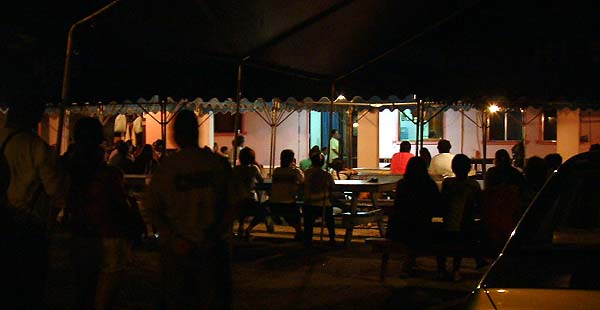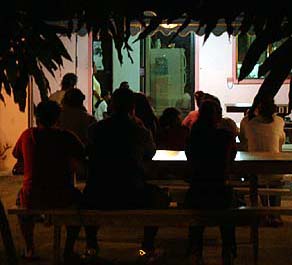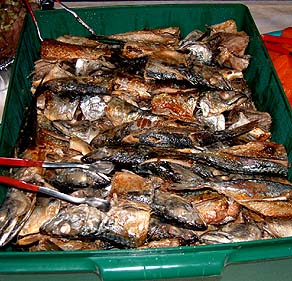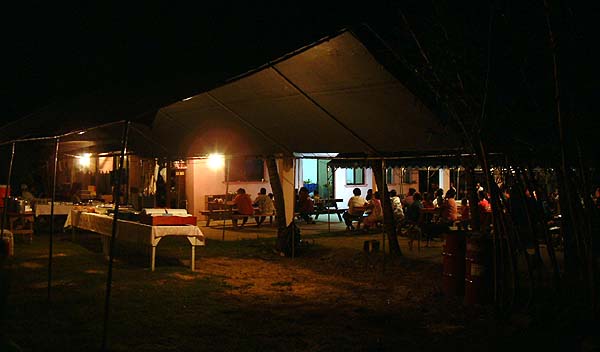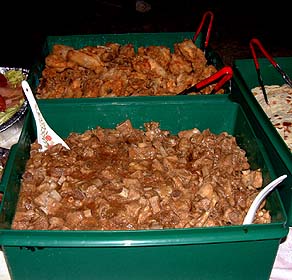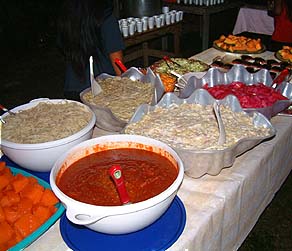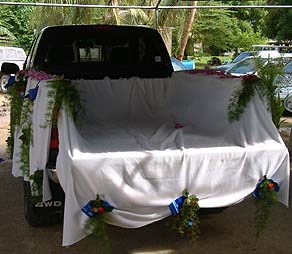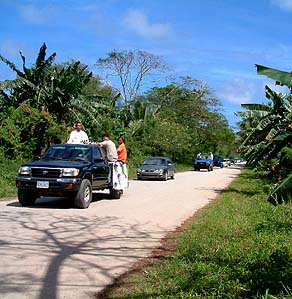 |
 |
 |
|||||
|
|
|
|
|
|
|
|
|
|
|
|||||||
|
|
|
|
|
|
“In the olden days when somebody died, usually the next day we would bury,” Ben says, “If this person died today, he or she would lie in wake and we would be there all night. During that time, we only bring coffee, sugar, milk, biscuits (those navy ship biscuits), maybe tortillas, the ones that are made at home, and that’s what we serve for the people who stay. “Now there are several stages of rosary. Rosary is prayers for the dead. We call it lisayu. In the evening around maybe 8:00, they will have the rosary and after the rosary people get to drink coffee, eat some biscuits, and then at midnight they will have another rosary, and again coffee and biscuits."
|
||
|
|
||
"And in the daytime before the priest comes for the last rites at the house, they will say the rosary again and then the last rites by the priest at the house and they’ll take the body out to the church and then they will have a 45-minute mass with the last rites at the church. "In the old days we only walked, we carried the coffin. There were no cars in those days. We carried the coffin up to the cemetery near the school, and buried there." “The rosary goes for nine days. It’s for the general public. And we would slaughter animals, cow, pig, whatever the family has, and we would share them with those who come to say prayers with us and pray for our lost one. "They would cut up raw meat and pass it out. They take it home and cook it later on. It’s an appreciation for their prayers and help, and the person who says the rosary gets a bigger chunk of that gift."
|
|
|
“We call that person a tetza. Usually the tetza are those who are very influential in church, those who follow the church religiously and that understand the prayers. Not everybody knows the hierarchies of the prayers, and so they would ask a person like my auntie Estella, who is very religious, who always goes to church and studies this rosary. They would ask her to say the rosary for the dead person. "Not a whole lot of people in the village can do this. Probably on my ten fingers I can count them and not use all my fingers."
|
“After the rosary, we would kill a pig or a cow," Noel says, "and then we’d slice it and give it, saying, ‘Okay you have been attending, here’s a piece you will take home.’ But recently it has kind of changed into people buying things: frozen chicken in the plastic bag. And we use the chicken instead. “After that, at the reception, the only food we had was cookies, coffee, and bread and butter. Okay, that’s it. And it’s always at the end of the Rosary. "Still there’s no drinking, no smoking, no music. Everything is so quiet."
|
|
|
|
|
|
“After the burial, there’s another nine-day period, for the family. After the first nine days for the general public, then we have another one for the family, it’s called lisayu guma, ‘rosary of the house,’ and so we would go down and give our contribution. Tomorrow I’m going to bring down one 30-pound yellowfin. That’s the contribution I’m going to give, and it’s for dinner or for lunch, whatever they desire. It’s their choice."
|
||
|
|
||
“In the old days, the family gave raw meat to people who came to attend the rosary. Today mostly we get families who will contribute. There are some friends who would give money and this money would be used to buy food. "Today it is so expensive because from day one, they serve solid food, every night you put out solid food and you’re looking at two or three thousand dollars’ worth of food that is prepared. You’re not thinking of the labor, you’re thinking only of the cost to purchase them. Aside from purchasing them, you’re going to have to cook them and that’s a whole day’s job. "And so nine nights of feeding people is very expensive, then the other nine nights, food would be served on a smaller scale because it’s now known to be only the family members or good friends."
|
|
|
“Somebody in the family would keep track as to who comes, who is there, what they bring, and then when they have the same thing happen, they will reciprocate. They would bring things of comparable costs. They remember that you showed up, so that when your turn comes, we make sure that we show up there too. "That has been happening from when I was young, although it has changed tremendously with the advent of commercialization and the availability of a lot of goods. "In the olden days, there were very few stores and very little money, and so you could only buy biscuits, butter, jam, stuff like that—the basic necessities to say ‘Thank you for your prayers, thank you for coming, thank you for helping us.’ It has changed tremendously today."
|
“Today even the attendees bring something. They say, ‘Let’s bring some food, let’s bring pizza or bring something from the store. Let’s bring bottles of water.’ Those things are now pretty common." “The food has changed," Noel agrees. "The table has become longer. There’s more food. So now, instead of fresh meat, you get to eat chicken, meat and other foods. And now every night there’s food all over the place. And there’s beers everywhere. So it’s really changed. To me, it’s just not right.”
|
|
|
|
|
| “One thing that’s our custom, which I still hold now," says Rosa Castro, "is when a family member dies, we Carolinians, when we’re going to close the casket cover, before we put the cover down we have to go buy six or eight kinds of cloth—you cannot buy five or three. I still use this custom because they taught me the custom of when people die. So I tell my kids, 'Go buy me six kinds of material,' so when they bring the casket, before they go to close it up, I have to cover the person with that cloth."
|
||
|
|
||
“After everyone comes to say goodbye to the person who died, when I know everybody is finished, I have to close down everything. What belonged to that person who died, I take and have to put in there before I close it. And the material—six or four or eight pieces—you cover and then close it. “Chamorros, I don’t know if they do that. Only Carolinians. I asked one of the old ladies, when I was small, I said, ‘Why do you people cover that dead person with so many clothes?’ Because they put the old clothes, beads, everything that belonged to him or her, they put it the coffin, then they cover with the material. "
|
|
|
“When the coffin is full already, you cover with new material, then they hammer the cover. But leftover things, you have to take them and, before they put that body down, we throw down those things on top of the coffin, at the cemetery. We say that those belonged to him or belonged to her, and they need to take them away. “I just want to say about family: when I have a family member die in my place, when they hear about it, my cousins and those people who know me, even though I don’t invite them, they come. Because they keep me in their hearts, I really open my eyes and my heart to them when it’s their turn."
|
|
|
|
“So that’s what I really like, because sometimes I don’t call them when somebody dies in my own family, soon they hear on the radio and they come. And they help. So I know they really care about helping family. So myself too, when I hear, even when they don’t tell me, I just call my kid and we go there and we help. I never throw this out from my head, I’m still keeping what my mom and my sister told me. I don’t need to wait. Soon as I hear, I just go.”
|
||
|
|
||
|
|
|
|
|
|

|
| Tanapag Home | Map Library | Site Map | Pacific Worlds Home |
|
|
|
|

|
|
|
|||
| Copyright 2003 Pacific Worlds & Associates • Usage Policy • Webmaster |
|||
